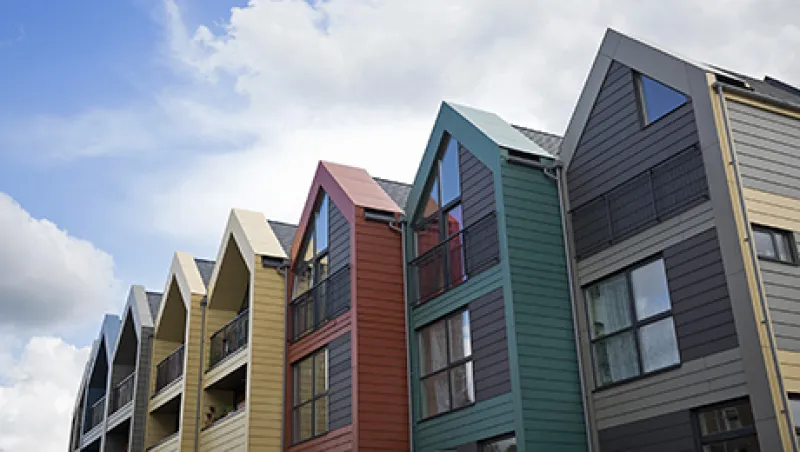Institutional investors have tended to neglect U.K. residential property in the rush to enter the £850 billion ($1.46 trillion) commercial market, a highly popular investment among overseas pension and sovereign wealth funds.
This situation, however, is beginning to change. The question of how to make money from housing has long been one of the staple conversations of dinner party table talk among middle-class Britons. Institutional investors are now joining in. Institutional investment in residential property rose from £1.6 billion in 2012 to £2.5 billion in 2013, according to Savills, the property agent headquartered in London.
Ed Crockett, London-based residential fund manager at £324.5 billion in assets under management Aberdeen Asset Management, the Aberdeen, Scotland–based investment management firm, says that “almost all” of its clients are now “showing interest” in residential investment. “The more adventurous have gone in, and others will follow suit,” he predicts. “Investment will really ratchet up.”
“Increasing numbers of large investors are looking to enter the market,” says James Coghill, head of residential capital markets at Savills. “We’ve started to see a lot in interest just in the past six to 12 months.”
The U.K. housing market is attracting foreign as well domestic buyers. In 2013 Dutch pension fund group APG announced a £158 million co-investment with Grainger, the U.K. residential landlord, in London properties. Swedish real estate company Akelius, owned by the Akelius Foundation, has made a number of purchases in London and the southeast of England.
The appeal of residential property, according to experts, lies in its potential as a hybrid investment. “Residential investment offers a double whammy: durable income and capital growth,” says Aberdeen’s Crockett.
Crockett notes that residential property generally has lower initial yields than does commercial property. “Once you’ve taken off expenses, good-quality residential stock offers 4 to 4.5 percent if you’re lucky,” he says. This compares, he estimates, with initial yields of almost 6 percent for good-quality commercial property. For investors who insist on central London, yields are, he says, below 2 percent—considerably below analysts’ estimates for most good-quality commercial property in the area. However, for commercial property, he adds, “over time capital value will go down. But in residential property, capital value will go up.” Tenants prefer modern, state-of-the-art office and retail property, but in the U.K. residential market, attractiveness does not decline with age.
The capital value of British residential property is constantly boosted by a deeply rooted structural imbalance between supply and demand. “The government’s own figures show a requirement for 250,000 homes a year, and we have actually built 112,000 over the past year,” says Alex Greaves, London-based residential fund manager at M&G Real Estate, part of U.K. investment manager M&G Investments with assets under management of £248 billion. “We’ve never met the requirements, and we’re highly unlikely to meet the requirements in any way, shape or form.”
The demand for homes has been boosted by high numbers of immigrants, but the supply is curtailed by strict planning laws and low levels of homebuilding by local municipalities — previously avid builders. In London, where the gap between supply and demand is particularly wide, house prices were up 15.5 percent year-on-year in the first quarter of 2014, according to the Halifax House Price Index.
M&G Investments bought 534 homes in London and southern England for £105 million from Berkeley Group, a developer, in 2013. It also owns properties in east London, close to London’s City and Docklands financial districts.
Institutional investors hope that over time they can increase yields by managing their portfolios more effectively. Savills’ Coghill says there is potential for institutional rental to become a “premium product,” able to charge tenants higher rents than small landlords. He cites the value-adding concierge services offered by apartment blocks in New York. In addition, social events such as wine tasting evenings could decrease vacancy rates — estimated at 3 to 5 percent for well-managed blocks. “If people can build relationships with other people in the block, they are likely to stay for longer,” he says.
Investors need also to consider what will happen to the residential market if interest rates rise, potentially hitting the capital value of their investments by deflating the house-price boom. Financial markets expect the Bank of England to raise its repo rate, currently 0.5 percent, by this time next year.
However, Aberdeen’s Crockett describes an interest rate rise as “not a huge problem.” He says that institutional investors in property are looking on a long-term basis, making them less susceptible to house price volatility. Many investors believe that even if house prices fall temporarily, the imbalance between supply and demand will keep them on a long-term upward trajectory.
M&G’s Greaves says that tighter monetary policy could, in one sense at least, even increase the investment potential of rental. “If interest rates rise, it will be more expensive for people to borrow money, and potentially more challenging for them to buy the kind of house they want. So there could be fewer people buying and more people going into the rental market.”
Get more on alternatives and investors.






